 W
WGhanaian cuisine is the cuisine of the Ghanaian people. Ghanaian main dishes are organized around a starchy staple food, which goes with a sauce or soup containing a protein source. The main ingredients for the vast majority of soups and stews are tomatoes, hot peppers and onions. As a result, most of the Ghanaian soups and stews are red or orange in appearance.
 W
WKoobi is tilapia salted dried fish in Ghana. The fish has an indigenous flavor in stews and soup in the Ghanaian local delicacies. It is used to prepare Ghanaian foods such as fufu, soup, plantain and stew and other local Ghanaian cuisines.
 W
WÀkàrà (Hausa: kosai, Portuguese: Acarajé is a type of fritter made from cowpeas; or beans - black eye peas. It is found throughout West African, Caribbean, and Brazilian cuisines. The dish is traditionally encountered in Brazil's northeastern state of Bahia, especially in the city of Salvador. Acarajé serves as both a religious offering to the gods in the Candomblé religion and as street food. The dish was brought by enslaved peoples from West Africa, and can still be found in various forms in Nigeria, Ghana, Togo, Benin, Mali, Gambia and Sierra Leone.
 W
WAcheke, also spelled attiéké or akyeke (Ghana), is a side dish made from cassava, and is a popular and traditional cuisine in West Africa. The dish is prepared from fermented cassava pulp that has been grated or granulated. Dried attiéké is also prepared, which is similar in texture to couscous.
 W
WAgbeli Kaklo is a Ghanaian snack made from cassava and eaten by the locals, the snack originated from the southern part of the Volta Region. It is very crunchy and mostly eaten with hard coconut. The snack is named as such because it is derived from cassava.
 W
WAkpeteshie is the national spirit of Ghana, produced by distilling palm wine or sugar cane. In Nigeria it is known as Ògógóró (Ogog'), a Yoruba word, usually distilled locally from fermented Raffia palm tree juice, where it is known as the country's homebrew. Today, there is a misconception that Ogogoro can be pure ethanol, but traditionally, it had to come from the palm tree and then be distilled from this source.
 W
WAprapransa, originally called 'Akplijii(or Akplidzi)' is a local GaDangme(or Ga) dish prepared by heat mixing(or blending) roasted corn flour with a sacred GaDangme(or Ga) soup called 'Palm Nut Soup'. As a point of emphasis, 'Palm Nut Soup', an important base ingredient in the preparation of 'Akplijii(or Akplidzi)', is an ancient sacred soup of the GaDangme(or Ga) people, and is always prepared as a complement to another sacred corn flour meal called 'Kpokpoi(or Kpekpele)' during an 'Ancient Religious Hebraic Harvest Festival' called 'Homowo'. The GaDangme(or Ga) people brought these practices along with them to 'Ancient-Ghana' and taught all the tribes how to prepare this delicious 'Palm Nut Soup', just like the 'Akans' taught all the tribes how to prepare their delicious soup called 'Abunebunu(or Ebunuebunu)'. It is worth mentioning that outside Ghana, other tribes such as the Yorubas, Igbos, etc. in Nigeria process 'Palm Nut' in a similar yet different fashion into soup called 'Banga Soup'. Over the course of time, the knowledge of the preparation of 'Palm Nut Soup' in Ghana became common and it lost it sacred status. It may interest Ghanaians to know that the GaDangme(or Ga) people have from 'ancient time' to 'present day', used the palm tree in a number of sacred ways; namely, (1) To prepare a sacred soup called 'Palm Nut Soup',, (2) The burning of the dry figs as incense for spiritual cleansing and to ward-off evil spirits, (3) To build new houses every year made up of new palm tree branches which in our present day has been seriously reduced in practice because of embraced modernity in socio-cultural attitudes, (4) etc. The sacred uses of palm tree is not unique to the GaDangme(or Ga)-Tribe, for it is a common practice among several other tribes in the 'Congo-Niger Family'(or Bantu-Zone) of Africa. Akplijii(or Akplidzi) also known as Aprapransa is a food that is served on special occasions and it is feared to go extinct.
 W
WAsaana is a popular caramelized corn drink made from fermented corn and caramelized sugar in Ghana with a refreshing taste. It is referred to as elewonyo in other parts of Ghana and known in so many countries as corn beer drink.
 W
WAyigbe biscuit is a Ghanaian snack created by Yonunawo Kwami Edze from Agbozume in the Volta Region.
 W
WBanku is a local term in the Ga-Dangme (Ga)-language coined for a cooked slightly-fermented mixture of corn-dough and cassava-dough made into dumpling to serve. It is distinctively a Ga-Dangme term. There are similar tonal terms with different meaning in the Ga-language, such as Inku, Ashanku, and many others ending in 'Ku'.
 W
WBraised rice is a Ghanaian style of cooking rice. It is known as angwa moo in the Akan language, literally "oil rice" or omɔ kɛ fɔ(omor ker for) in the Ga language. It is prepared with few ingredients. and is usually balanced with some vegetables and any other accompaniment to balance the diet. The braised rice is served with ground pepper or shito, and served with fried eggs, omelette or sardine.
 W
WẸ̀bà is a staple food mainly eaten in the West African sub-region, particularly in Nigeria and parts of Ghana. It is specifically called Eba by the Yoruba people. It is a swallow food made from dried grated cassava (manioc) flour, commonly known as garri.
 W
W'Oto(or Otor)' is the original name not 'Eto(or Etor)' which is an 'Akan' corruption of the actual name. As a ponit of interest rooted in documentary evidence and fact, 'Eto(or Etor)' has no meaning, but 'Oto(or Otor)' has a meaning in the Ga-language and a precise definition in publications dated as far back as in the 1800s and/or before. It is a sacred food formulated by the GaDangme(or Ga)-Tribe of Ghana for special occasions and/or events such as: (1) The GaDangme(or Ga) well celebrated 'Twins-Festival, (2) GaDangme(or Ga) Outdooring Naming Ceremony and/or '8th Day Abrahamic' Circumcision, which is now widely observed by other tribes including the 'Akans', (3) Birthday celebration of which predominantly the mashed-yam version of the GaDangme(or Ga) sacred 'Oto(or Otor) food is used, with seldom use of the mashed-plantain version, (4) Wedding Event, (5) GaDangme(or Ga) Dipo/Atofo(or Otofo)/Ashimi Puberty Rites, (6) etc. It is worth mentioning that the GaDangme(or Ga) sacred 'Oto(or Otor)' food comes in various forms; namely, (1) The 'Mashed-Yam' form, (2) The 'Mashed-Plantain' form, (3) etc., and has been widely adopted by some of the neighbouring 'Akan-Tribes' in their culture. The GaDangme(or Ga) 'Oto(or Otor)' is the most popular of the sacred foods prepared for the twins during the 'Twins-Festival'. Others such as 'Naji Enyo' OR 'Naji Ejwe' is not as popular.
 W
WFufu is a dough-like food made from fresh or fermented cassava, found in West African as well as Caribbean cuisines. In addition to Ghana, it is also found in Sierra Leone, Guinea, Liberia, Cote D'Ivoire, Benin, Togo, Nigeria, Cameroon, the Democratic Republic of Congo, the Central African Republic, the Republic of Congo, Angola and Gabon. It is often made in the traditional Ghanaian, Cote D'ivoire, Liberia and Cuban method of separately mixing and pounding equal portions of boiled cassava with green plantain or cocoyam, or by mixing cassava/plantains or cocoyam flour with water and stirring it on a stove. The viscosity is then adjusted based on personal preference and eaten with broth-like soups. Some countries, particularly Nigeria, have a version of fufu made from fermented Cassava dough that is eaten with thick textured stews. Other flours, such as semolina, maize flour, or mashed plantains may take the place of cassava flour. Fufu is eaten with the fingers, and a small ball of it can be dipped into an accompanying soup or sauce
 W
WA fufu machine is a kitchen appliance used to pound cooked starchy vegetables, particularly cassava, plantains, or yams, into the West and Central African staple food fufu.
 W
WFunge or fúngi (Angola) or mfundi is a type of porridge or swallow that can be made with sorghum, maize or millet grains, or cassava. It can be served with stew, or a vegetable or meat dish. It may be made with a stiffer consistency to be eaten with the fingers. Funge is a staple food in African cuisine. Some richer and more flavorful versions may be made with stock, like fish stock, instead of water. It is also known as bidia.
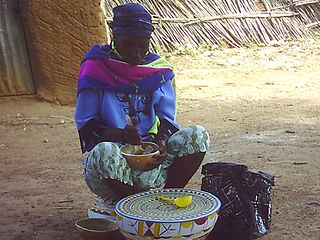 W
WFura is a type of food which is known to have originated from the Fulanis and Hausas in West Africa.It is a millet dough balls which is also eaten in Niger and Ghana.
 W
WGari and beans is a type of dish made of staple foods in Ghana. It is usually common in the southern parts of Ghana popularly called bober, borbor or gobe, yo ke gari and even red red.
 W
WGari Soaking is popular Ghanaian dessert made with gari. As the name implies, it is made by soaking the gari in water or milk.
 W
WIn West Africa, garri refers to the creamy granular flour obtained by processing the starchy tuberous roots of freshly harvested cassava.
 W
WHausa koko also known as spicy millet porridge, is a Ghanaian street food commonly eaten as breakfast meal. It can also be taken in late afternoon as snack. It is made from millet with a few local spices added to give it a particular taste and color. It is called Hausa koko because of the notion it was created in the Northern areas of Ghana. It is also common in the various communities in Ghana.
 W
WIpomoea aquatica is a semi-aquatic, tropical plant grown as a vegetable for its tender shoots. This plant is known in English as water spinach, river spinach, water morning glory, water convolvulus, or by the more ambiguous names Chinese spinach, Chinese watercress, Chinese convolvulus or swamp cabbage, or kangkong/kangkung in Southeast Asia and ong choy in Cantonese. Its place of origin is not known.
 W
WIce kenkey is a popular Ghanaian dessert made from kenkey, a steamed dumpling made from fermented cornmeal. It is often sold as a street food in Ghana.
 W
WJollof, or jollof rice, is a rice dish from West Africa. The dish is typically made with long-grain rice, tomatoes, onions, spices, vegetables and meat in a single pot, although its ingredients and preparation methods vary across different regions.
 W
WPlantain, believed to have originated in southeast Asia refers to the cooking banana, cultivars of the banana plant, which produces an edible fruit that is full of starch and rarely eaten raw. Though similar in appearance, the two banana varieties are typically used in very different ways. Usually, in many cultures where this fruit is a staple diet, it is boiled, fried, or cooked while green due to the starch levels. In some African regions, the plantain can be reduced to flour or for beer-making. However, in many instances an encounter with plantains is usually in fried form.
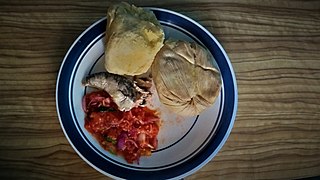 W
WKenkey is a staple dish similar to sourdough dumpling from the Ga and Fante-inhabited regions of West Africa, usually served with pepper sauce and fried fish or soup, stew.
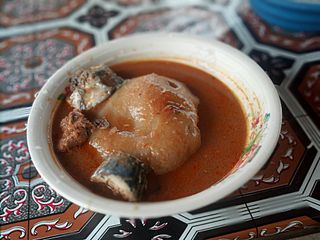 W
WKokonte is a staple food, eaten in some parts of Africa including Togo, Ghana and others. In Ghana, Kokonte is eaten by most of the ethnic groups like the Ga, Akan, Hausa. Kokonte is also known as "Face The Wall" because it was initially associated with the low class, and one wouldn't want to eat it due to that. It is also a popular term used by the Ghanaian locals. Kokonte usually is brown, grey and deep green depending on the type of ethnic group that prepares the dish. Kokonte is usually prepared out of dried cassava or yam.
 W
WKontomire stew is a stew made from cocoyam leaves, commonly prepared in the home and very popular in Ghanaian cuisine. In Ghana, kontomire stew is served with variety of dishes, including steamed rice, cooked yam and plantain. Its English designation palava sauce is said to originate from the people of Elmina.
 W
WKoose is a spicy black-eyed pea fritter that is commonly eaten in West Africa as a snack.
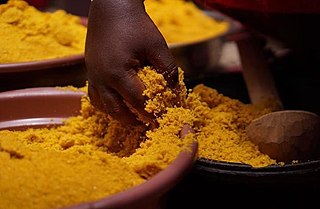 W
WKpekple is a kind of food eaten by the Gas of Ghana during the celebration of Homowo festival, which is to hoot at hunger. It is prepared with the primary ingredients of steamed and fermented corn meal, palm nut soup and smoked fish. Kpekple is usually sprinkled around by the chief believing that the ancestors would be pleased by the offering.
 W
WKube Cake, also known as Kube Toffee, is a Ghanaian locally made candy.
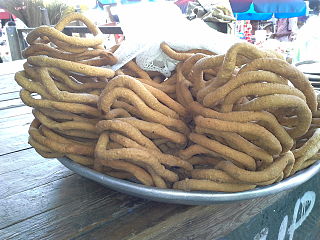 W
WKuli-kuli refers to a West African snack that is primarily made from peanuts. First made by the Nupe People of West Africa it is a popular snack in Nigeria, Benin, northern Cameroon and Ghana. It is often eaten alone or with a mixture of garri also known as cassava flakes, sugar and water popularly called "garri soakings". It is also eaten with Hausa koko, fura, kamu; and is sometimes ground and put into salad. It is often ground as used as an ingredient for Suya and Kilishi.
 W
WKyinkyinga or Cincinga, is a grilled meat skewer or kebab that is common and popular in West Africa and is related to the Suya kebab. Kyinkyinga is a Ghanaian Hausa dish popularised by traders in the Zango areas of town and cities, and has since becoming popular among other Ghanaians. It is hence very similar to or synonymous with the suya kebab in Nigeria and Niger, also known as suya, tsinga, cinga, cicinga, cincinga, tsire agashi, cacanga or tankora in the Hausa language
 W
WLight Soup is a local indigenous soup of the GaDangme(or Ga) people of the Greater Accra Region of Ghana. Originally formulated as a 'Tomatoes-Base Sea Fish Light Soup' called 'Aklo(or Aklor)' for fishermen at the coast of Accra, but over the course of time it evolved into a soup prepared with both 'fish and goat-meat', or 'fish and lamb-meat', or 'fish and beef', or 'exclusively the meat of the livestock of choice', and of which the GaDangmes(or Gas) call 'Toolo Wonu', but their neighbouring 'Akans' call 'Aponkye Nkrakra'. The delicious local indigenous 'Light Soup' of the GaDangme(or Ga) people paved the way for the formulation of GaDangme(or Ga) MEALS such as: (1) 'Komi Ke Aklo(or Aklor), Garnished With Cooked Blended Okro', (2) 'Banku Ke Aklo(or Aklor), Garnished With Cooked Blended Okro', (3) 'Yele(Chops of Boiled-Yam) Ke Aklo(or Aklor)', (4) etc., and similar meals of the 'Toolo Wonu' version, and to name a few: (1) 'Yele(Chops of Boiled-Yam) Ke Toolo Wonu', (2) 'Atomo(Chops of Boiled-Potatoes) Ke Toolo Wonu', (3) etc.
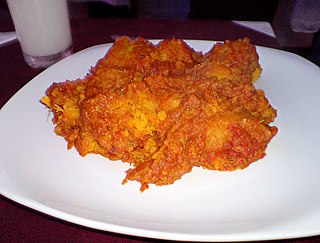 W
WMpoto Mpoto is a Ghanaian cuisine made from cocoyam or yam. It is also known as Yam Pottage and Asaro by the Nigerians. It is made from several ingredients including fish and onion.
 W
WNkatie Cake also known as Peanut Cake is a Ghanaian snack. Nkatie cake is usually in a candy bar or shaped in any form made with groundnuts or peanuts and melted sugar. This snack is also common in Guinea, they refer to it as Kongodo and in Senegal it is known as louga. The snack is eaten by both the young and old, but very common among school children.
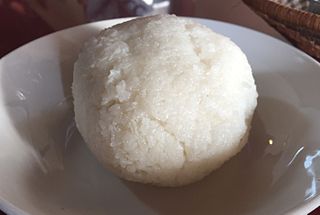 W
WOmo tuo is a Ghanaian staple food made with rice. Mostly, "broken rice" or long grain rice broken into smaller pieces is used. The rice is usually cooked with more water than usual to make it softer. It is then beaten to make it smooth, after which it is shaped into sizable balls. In Ghana, it is usually served with soup made of groundnut or palmnut. In Nigeria, it may accompany miyan kuka.
 W
WPalaver sauce or palava sauce or plasas is a type of stew widely eaten in West Africa, including Ghana, Liberia, Sierra Leone and Nigeria. The word palaver comes from the Portuguese language and means a talk, lengthy debate or quarrel. It is unclear how this led to the name of the stew. One theory is that the spices used in the stew mingle together like raised voices in an argument. It has been thought of as having the power to calm tensions, or to cause them. Other names for the dish include Kontonmire, Kentumere, Nkontommire and pla'sas.
 W
WPalm nut soup is a soup made from palm fruit and it is common in the African community. It originated from the Urhobo tribe in Delta State, Nigeria. Palm nut soup has become a continental soup.
 W
WPeanut soup or groundnut soup is a soup made from peanuts, often with various other ingredients. It is a staple of African cuisine but is also eaten in East Asia (Taiwan), the United States and other areas around the world. It is also common in various Latin American regions, such as Argentina, Bolivia and Peru, where it can sometimes be served with bone meat and hollow short pasta or fries. In Ghana it is often eaten with fufu or omo tuo. Groundnut soup is also a native soup of the Benin (Edo) people in Nigeria and it is often eaten with pounded yam. Some of the essential ingredients used in making it are Piper guineense and Vernonia amygdalina.
 W
WPeanut stew or groundnut stew, also called as maafe, sauce d'arachide (French), tigadèguèna or domoda, is a stew that is a staple food in Western Africa. It originates from the Mandinka and Bambara people of Mali.
 W
WPoloo is a Ghanaian snack which is referred to as fried coconut dough or fried biscuit.
 W
WRed red is a Ghanaian dish composed of black eyed peas, cooked in palm oil/vegetable oil with plantain. The dish derives its name from the red color it takes on from the red palm oil (zomi) and the fried plantain. Red red typically consists of fish, such as tinned mackerel or pilchards, black eyed peas, scotch bonnet peppers, onions, oil and tomatoes. It is commonly known in Ghana as "kokoo ne beans". Though often served with fish, red red can also be vegetarian. It can be served with fried plantain, avocado, and rice or garri for a complete meal.
 W
WRoselle juice, known as bissap, wonjo, foléré, dabileni, tsobo, zobo, or sobolo in parts of Africa, sorrel in the Caribbean, and agua de Jamaica in Mexico, is a drink made out of the flowers of the Roselle plant, a variety of Hibiscus. Although generally the "juice" is sweetened and chilled, it is technically an infusion and when served hot can also be referred to as hibiscus tea.
 W
WShito is the word for a particular pepper sauce in Ga, a Ghanaian language from Accra, the Ghanaian capital. Whilst the word for pepper is different for each of the Ghanaian native languages, shitor din, commonly called 'shito', is widely used as the name for the hot black pepper sauce ubiquitous in Ghanaian cuisine.
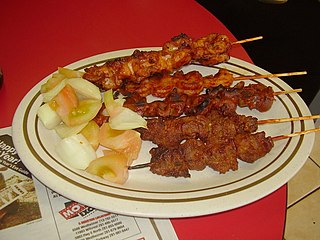 W
WSuya or tsire is a spicy meat skewer which is a popular food item in West Africa. It is also eaten in Sudan, referred to as "Agashe". Suya is generally made with skewered beef, ram, or chicken. Innards such as kidney, liver and tripe are also used. The thinly sliced meat is marinated in various spices which include peanut cake, salt, vegetable oil and other flavorings, and then barbecued. Suya is served with extra helpings of dried pepper mixed with spices and sliced onions. Halal meat preparation methods are normally used, especially in the northern parts of Nigeria, where the suspicion of nonconformity to Muslim dietary prohibitions in Suya preparation has been known to cause riots. A dried version of Suya is called Kilishi. It can be eaten with Garri or Ogi.
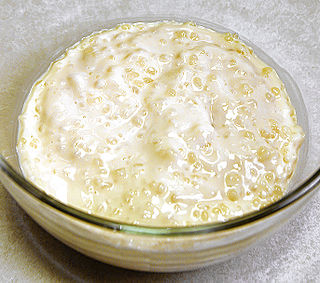 W
WTapioca pudding is a sweet pudding made with tapioca and either milk or cream. Coconut milk is also used in cases in which the flavor is preferred or in areas in which it is a commonplace ingredient for cooking. It is made in many cultures with equally varying styles, and may be produced in a variety of ways. Its consistency ranges from thin (runny), to thick, to firm enough to eat with a fork.
 W
WTubaani also referred to as steamed black-eyed peas' pudding is a popular Ghanaian dish that is commonly eaten in the northern regions and Zongo communities of Ghana. The dish consists of a paste made from the flour of black-eyed peas and water which is then cooked after being first wrapped in the sweet-tasting, aromatic leaves of the Marantaceous herb Thaumatococcus daniellii and served with gravy or pepper and sliced onions tossed in hot vegetable oil.
 W
WWaakye is a Ghanaian dish of cooked rice and beans, commonly eaten for breakfast or lunch. However, others eat it for supper. The rice and beans, usually black eyed peas or cow beans, are cooked together, along with red dried sorghum leaf sheaths or stalks and limestone. The sorghum leaves and limestone give the dish its characteristic flavor and a red appearance and the sorghum is taken out before consumption. The word waakye is from the Hausa language and means beans. It is the contracted form of the full name shinkafa da wake which means rice and beans.
 W
WWasawasa is a popular dish, eaten in the Northern part of Ghana, and in some West African countries such as Burkina Faso. It is made from dried yam peelings which have been grounded into flour and steamed. Wasawasa is mostly eaten with spicy sauces and sometimes garnished with vegetables accompanied with raw groundnut oil and fried fish. Wasawasa is sometimes served with shea butter oil and sliced onions.
 W
WWest African cuisine encompasses a diverse range of foods that are split between its 16 countries. In West Africa, many families grow and raise their own food, and within each there is a division of labor. Indigenous foods consist of a number of plant species and animals, and are important to those whose lifestyle depends on farming and hunting.
 W
WZowey, also known as Dzowey, Dakuwa, Donkwa or Adarkwa, is a Ghanaian snack combining peanut paste, sugar, salt, water, ginger, and powdered maize flour.